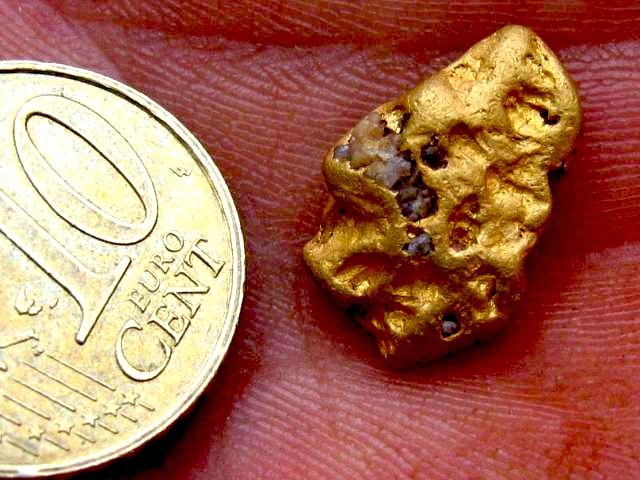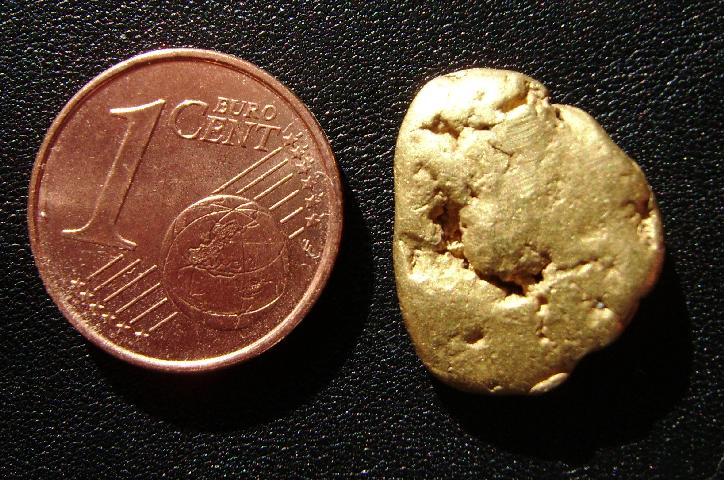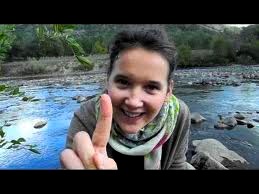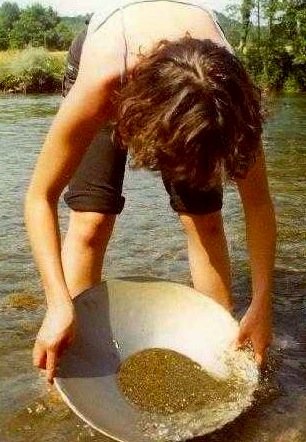Gold and Witches in Ariège!


Gold nuggets from the Ariege River
This river L'Ariège has its source at the Lac Noir, not far from Port d'Envalira, one of the highest peaks in the Pyrenees at 2,400 metres, on the border with Andorra. Running north-east in a narrow valley with deep gorges, the river arrives at Ax-les-Thermes, where it is joined by other rivers whose waters descend as waterfalls, so steep are the valleys. “There are traces of an ancient glacier,” say the geologists.
From Ax-les-Thermes it turns west for Tarascon, passing through Ussat-les-Bains where the caves in the cliffs were reputedly used by the Cathars when on the run from the Inquisition of the 1230’s. The river becomes much wider and passes the Devil’s Bridge to continue to Foix and then Pamiers. Now stately and calm, it passes through Cintegabelle and Auterive and joins the mighty Garonne river at Pinsaguet, just to the south of Toulouse. On the far bank is the town of Vielle-Toulouse, where lived the Celts who guarded “The Gold of Toulouse.”
They were incredibly rich until the Romans attacked them.
The name Ariège comes from the Latin “Auriger flumen” - the river of Gold. It carries nuggets and grains of this precious metal, as does the river Salat at St. Lizier. Hurtling down the slopes of the Pyrenees or the Corbières, the rivers carry legends and glittering flakes of gold alike. The Romans had a gold mine at the Pic de Baxouillade at Orlu and another of silver at Aulus-les-Bains.
In 1750, the Ariège river produced 50 kilos of gold, collected by placing a sheepskin in the flowing river, from where comes the legend of the Golden Fleece. If the sheep go in the river to cool down in summer, gold can be found in their fleeces afterwards. This was known to the ancient Greeks and the Romans worked the gold mine at the Pic de Baxouillade at Orlu and a silver mine at Aulus-les-Bains. The beds of the Pyrenean rivers are scattered with pebbles of gold. Today you can go on holiday and pan for gold. This is allevial or sedentary gold, flecks, grains or nuggets of it.
I was once told by a hotel-keeper in Carcassonne that there is more gold in the Pyrenees and the south of France than any other country in Europe. Gold is not the rarest precious metal to be found in nature, but it has always been considered to be the most valuable, because of its malleability. The mines near Carcassonne, at Salsigne, extracted the gold from gold-bearing rocks, so it is not “free” as is the gold in the rivers. (Salsigne was worked by the Romans and the Visigoths and only closed comparatively recently - about 12 years ago - because the gold was nearly exhausted while the miners wages had risen rapidly.
Another way of finding gold was to socialise with the fairies.
Fairies and genies torment humans and influence the climate. They lived in the Pyrenean grottos and in the evening, bathed in the clear streams where their long blonde hair caught the grains. When in love with humans they gave both themselves and the gold, but those who betrayed them found the gold had turned to pebbles.
These ladies with webbed feet like the sirens, attracted men by the songs and dancing. They took the most handsome for themselves and one never saw them again. Those who did, and escaped to tell the tale, remained a little idiotic. Fairies were fada in the old Occitan language.
Another creature who lives in rivers of Ariège, in the river Aude too, is the Drac, sometimes amusing but sometimes dangerous, attracting children and fishermen and then drowning them, as at Mas-Cabardes and the Trou de Viviès near Narbonne. By this Trou existed a fabulous horse which terrorised the children. He stole them, placed them on his back one after the other, and his rump grew longer with each one. He carried them to the Trou and they were never seen again.
At Mas-Cabardes it was an ass or donkey that carried away the children. One day he crossed the river with a dozen children on his rump. He dropped them off, changed his shape, and flew off to perch on a rock, laughing as he played his trick with the unhappy children.
The feminine version of the Drac is called Salimonde or Saurimonde. The one at Lastours carries the body of a goat and lives under the Cathar castle. Those at Greffeil change into an animal once a year. Saurimonde can also take the aspect of an abandoned little girl - bad luck for generous-hearted parents who decide to adopt her! This story originated on the Montagne Noire. There were magic procedures against the Drac; most involved nails for some reason, one boiled them in a house with all the doors and windows shut, or one placed them in milk that one gave the Drac if he came to call. You could protect yourself against the Drac by placing the chairs around the table in a certain way, or by piling up the sheets in the cupboard in a certain way. It was up to the women!
Fairies and Salimondes influence the climate - they announce bad weather with loud cries and they let loose storms. In the Pyrenees one tries to appease them with offerings. The fairies are responsible for terrible floods. In 1632, Louis XIII lost two hundred soldiers on guard at Coursan. Limoux, ravaged since 1174, knew eight gigantic floods until the one of 1820 which destroyed a hundred houses. The department of Aude counted 200 dead in 1930 and another 20 in 1999.
At Narbonne and Gruissan the sailors pilgrimages and the seaside fêtes give Cathar country an accent of another world. Saint Peter himself landed on the coast of Aude and at Leucate village they carry statues of him from the churches of his name, down to the sea to bless the waves.
Miraculous sources in the Ariège department include, close to St. Girons, Eycheil where St Lizier caused the source to gush and flow while kneeling in prayer. It happens to cure infertility and during the night of St. Jean, the women would come to rub their “sexe” against the relic of St Lizier, presumably. There is also the source of Saint-Martin d’Oyds which cures fevers and that of Gourbit which cares for epileptics and that at Loubières which makes beautiful those who see themselves reflected in the purity of the water.
Countless appearances of fairies have been signalled in Aude and Ariège; at Val d’Amour at Belesta, at the monastery of Baulou, at Montségur, Pailhes, Cadarcet, Soulan, Montjoie, Sabarat, Crampagna, Bédeilhac, Massat, Aigues-Juntes, Mercenac, Sarat. The Ariège department is one of the most backward or pagan in France, according to how you look at it. In the mountains where stories were passed down father to son or mother to daughter, the “old religion” took a long time to die out.
There’s a story in Montségur of Ferrocas, who told his priest in front of the congregation that he alone practised the true religion, the faith of the mountains and forests. He would find Jesus his saviour in a future life, he told his priest, which was a Cathar belief. The priest refused to bury this pagan Ferrocas, so he was buried like a suicide at the crossroads outside the village and a may-tree was planted on top of him, which thrived, until the church cut it down in the 1800’s.
Around that time iron crosses were placed on all roads entering villages, you can still see them today. At Montségur is the Cross of Ferrocas. Presumably the Cathar remains are still beneath it.
he beads of amber certainly suggest trade with northern or Baltic nations.
Cabaret, the first tower, built in Roman times, was named after the copper - Caput Arietis Castra, in Latin. Forges have been found, dated up to the second century AD, that used charcoal furnaces, capable of reaching 1200 degrees Centigrade, to heat, soften and work the metals.
As the Visigoths were trading in amber for hundreds of years before they moved south in Roman times, It’s possible they knew of this region long before they came to France under the Roman umbrella. The discovery of Visigothic tombs, dated 5th century, that is, before 500AD, proved they were living and working in this region before that; they came to France in 412AD.
Hautpoul, meaning High Pool, was founded by the Visigoths in the 5th century. King Ataulf and his Roman princess Galla Placidia turned north from Carcassonne to investigate the Montagne Noire, especially as it was known to be rich in Roman gold and silver mines, especially at Salsigne. They would have seen the defensive Roman watchtower of Cabaret in what is now Lastours, and continued as far as the east-west valley connecting Béziers with Toulouse.
The name Hautpoul suggests they found water there. They were obliged to stop, so the local legend says, for the gallant and brave Galla Placidia was expecting a baby; but she and Ataulf were not married according to Roman law. The baby was a girl. As soon as the plans for a defensive castle there were finalised, it’s likely they left the baby girl with a wet-nurse and continued their gruelling travelling. It’s said the Hautpoul family, who played such a role in the Rennes-le-Château story, are descendants of the Visigothic King Ataulf.
Some genealogies say that Ataulf and Galla Placidia had a daughter called Clotilde, born in 413. The baby girl was conceived after Ataulf and Galla had had their first marriage in Fiorli, and was born before they reached Narbonne in September 413. Later, did the foster-parents take the girl to the newly-founded Rhedae to live with her Visigothic cousins, or did she stay at Hautpoul and married into the Hautpoul family so the Hautpoul descendants had royal Visigothic blood? It’s known from archives in Mazamet that the name Hautpoul was known in 930. In 960 Bernard Raymond d’Hautpoul negotiated a peace treaty between the King of France and the Lords of Languedoc, while in 1096 Pierre-Raimond d’Hautpoul distinguished himself during the First Crusade, at the siege of Antioch.
Inscrivez-vous au site
Soyez prévenu par email des prochaines mises à jour
Rejoignez les 21 autres membres


